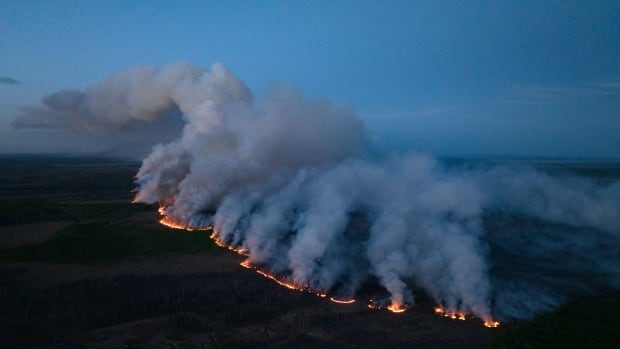Global Courant 2023-05-15 01:55:12
In northeastern BC, large wildfires continue to spiral out of control as unusually warm weather challenges firefighters.
Dozens of people stayed out of their homes in areas around Fort St. John, BC, on Sunday because of order evacuation And warnings in connection with the Red Creek fire, which has been burning for over a week now.
A newly discovered fire called the Stoddart Creek fire, just north of Red Creek, has prompted a house-to-house evacuation operation due to the safety risks associated with that fire.
The Stoddart Creek wildfire was discovered around 3 p.m. PT on Saturday and is burning in an area of 12.31 square kilometers. As of Sunday afternoon, 136 homes have been evacuated, according to the Peace River Regional District.
The wildfires come as a heat wave continues through the province, with little respite for the BC Wildfire Service emergency response team.
“It’s May so it feels early, but we’ll see the conditions in July,” said Hannah Swift, a firefighter’s officer.
Daytime temperatures will be 10C to 15C above the seasonal average until at least Tuesday, according to Environment Canada.
As of Sunday afternoon, the Stoddart Creek fire covers an area of 12.31 square kilometers – nearly three times the size of Stanley Park. (BC Wildfire Service)
The hot conditions are contributing to extreme drought in the Peace region of northeastern BC, where the largest fires are raging. Additional firefighting resources are deployed to what is being dubbed the North Peace Fire Complex, consisting of four major blazes.
Swift says the high spring temperatures — which have already accelerated snow melt in much of the province — have meant the Peace region has had little time to recover from the drought that began last fall.
Unusually hot & dry conditions in the North Peace region continue to challenge first response efforts. A pic.twitter.com/Lau1HpmFiK
“As we came out of winter and headed into spring, we had the snow melt and we went right back to summer (conditions),” she said. “We’re seeing very high temperatures very early in the day, very low relative humidity. So that burning window — where we’re seeing a sort of spike behavior — is getting longer and longer.”
However, Swift says crews are continuing to make good progress in burning the Boundary Lake fire on the BC-Alberta border, having conducted planned ignitions to contain the fire’s growth. Three homes were destroyed by fire last week.
Crews are seen here conducting a planned ignition operation, to contain fire growth, along the boundaries of the Boundary Lake fire on the BC-Alta. border on May 13. (Adam Buchanan/BC Wildfire Service)
As of Sunday afternoon, 56 fires have been raging in BC and 15 of them are considered uncontrollable.
An evacuation alert means residents should prepare to evacuate their homes, possibly with little to no notice. An eviction notice means that a resident must leave immediately.
LOOK | How the jet stream carries smoke from wildfires:
What’s going on up there that makes the weather down here so extreme?
May 12, 2023 Johanna flies high to investigate how the changing jet stream is making our weather more extreme. In addition, she gets brain freeze.
Smaller fire discovered in Metro Vancouver
The Peace River Regional District also issued evacuation orders for a “remote area” north of Fort St. John due to the Donnie Creek and Tommy Lake fires. The Donnie Creek wildfire covers an area of 263 square kilometers.
In a statement, the district says the area is “primarily used by the forestry and oil and gas industries,” with BC’s energy regulator saying some fossil fuel operations have already been halted due to fire activity.
The planned ignition operation at the Boundary Lake fire covered an area of 150 acres (1.5 square kilometers), and the blaze is expected to grow slightly larger. As of Sunday afternoon, it has an area of 61.71 square kilometers. (Adam Buchanan/BC Wildfire Service)
“Most of the fires we see in this area are believed to be human-caused,” Swift said.
“We’re really asking the public to help us with that, to make sure they give their best when they recreate,” she continued. “So that we can focus on the fires we already have and make progress on those fires, because the new ones will only divert our resources further.”
It was a busy and long night for the crew who are our friends pic.twitter.com/VKOsgmHy67
While many of BC’s most concerning fires are raging far away from the coast, a much smaller blaze was reported around 9 p.m. in Farrer Cove, adjacent to Belcarra Regional Park in Metro Vancouver.
Jay Sharpe, of the Sasamat Volunteer Fire Department, said the fire was under control after firefighters worked overnight, adding that it was likely caused by a power grid failure and that the incident has highlighted the need for extra vigilance in the heat. showed.
There is a Category 2 and Category 3 fire ban — which includes open fires that burn material in piles, as well as burning stubble or grass and fireworks — in effect in the central interior and northern B.C.




